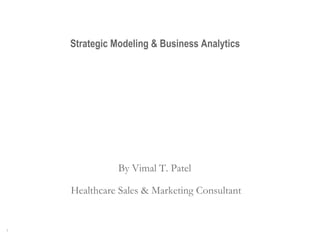Strategic Modeling And Business Analysis
- 1. Strategic Modeling & Business Analytics By Vimal T. Patel Healthcare Sales & Marketing Consultant
- 2. Market Snapshot - Porter’s Five Forces
- 3. Five Forces of Competition Model Potential Entrants Buyers Substitutes Suppliers Industry Competitors Rivalry Among Existing Firms Threat of Substitute Products or Services Threat of New Entrants Bargaining Power of Buyers Bargaining Power of Suppliers
- 4. Five Forces of Competition Model (Expanded) New Entrants Buyers Substitutes Suppliers Industry Competitors Intensity of Rivalry Threat of Substitutes Threat of New Entrants Bargaining Power of Buyers Bargaining Power of Suppliers Entry Barriers Economics of Scale Proprietary product differences Brand identity Capital requirements Access to distribution Absolute cost advantages Proprietary learning curve Access to necessary inputs Proprietary low-cost product design Government policy Expected retaliation Rivalry Determinants Industry growth Fixed (or stage) costs/value added Intermittent overcapacity Product differences Brand identity Switching costs Concentration and balance Informational complexity Diversity of competitors Corporate stakes Exit barriers Determinants of Supplier Power Differentiation of inputs Switching costs of suppliers and firms in the industry Presence of substitute inputs Supplier concentration Importance of volume to supplier Cost relative to total purchases in the industry Impact of inputs on cost or differentiation Threat of forward integration relative to threat of backward integration by firms in the industry Determinants of Substitution Threat Relative price performance of substitutes Switching costs Buyer propensity to substitute Bargaining Leverage Buyer concentration versus firm concentration Buyer volume Buyer switching costs relative to firm switching costs Buyer information Ability to backward integrate Substitute products Pull-through Price Sensitivity Price/total purchases Product differences Brand identity Impact on quality/performance Buyer profits Decision makers’ incentives Determinants of Buyer Power
- 8. Ěý
- 9. SWOT Matrix
- 11. Innovation Model
- 12. Executing on Innovation & Performance Management
- 15. Development & Engineering Solutions
- 16. Ěý
- 17. Ěý
- 20. Sample Brand Audit Sheet strong fun weak value Market Position: Dominant (#1 in the region) Strong (#2 or #3 in the region) Weak (#4 or lower in the region) NP – Not present in the region Brand Positioning: Quality, value, upscale, fun, adventurous, premium, safe, reliable, trustworthy, aggressive, cheap, etc. Cash Status: Cash generator Cash neutral Cash user Brand Analysis
- 21. Factor Analysis
- 23. Acknowledgements Harvard Business Review, Zantheus, Wikipedia, & Friends






















